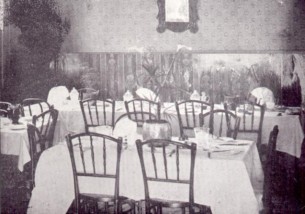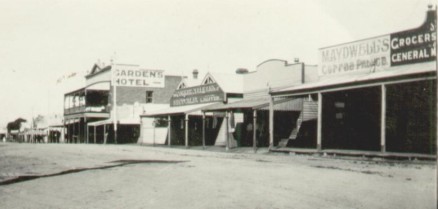


View of the dining room in Mrs Lugg's Crown Cafe, 1911 from The Progress of Sea Lake. Best Street, 1915. Bert Stubbs' new shop is just to the east of Maydwell's Coffee PaIace. Stubby's famous tea-chest is at the ready! In 1917 business had grown to the point that staff were required and Mr Crawford and Miss Myrtle Brock, who remained in the Stubbs employment for many years after her marriage to Mr Ted Wookey, were paid the wage of £2/13/6d and £1 respectively per fortnight. Other staff in the period up to the 1930s included Misses Gleeson, Sands, Hams, McMahon, Bowd, Stacey, Blair and Baker. When the property between the Royal Hotel and the Commercial Bank, formerly Allen's Bakery and Mrs Bennett's Drapery, became available in 1918 it was purchased from Angelo Travaglia of Castlemaine by Mrs Stubbs at a price of £475. The former bakery was obviously in a dilapidated condition as the insurance papers state that in 1919 the building was used as a storeroom for chaff and oats, supposedly for the family horse. With the increase of the homeless carriage Stubby finally relented and in 1921 purchased from H. J. Dixon of Sea Lake Motor Garage a "Latest Model T Ford" at £340/10/- with a spare tyre and tube thrown in! Years later an old family friend confessed to me that he and a mate had been involved in a youngster's prank concerning the "T" Ford. One afternoon while the Ford was parked behind the shop the two lads scaled the fence and ran steel needles through the tyres! On leaving the scene of the crime our friend was apprehended by Stubby but such was his nature that no charges were laid, rather a period of penance was introduced - to train and care for one of Stubby's greyhounds. Unfortunately for our friend the dog soon died. Eventually he had to own up to the death of the dog expecting the worst but the prank had been forgotten. By the early 1920s with an expanding business it became clear that the former Crown Cafe was unsuitable so a local builder was engaged to make some alterations. Partition walls and box windows were removed and the ceiling relined. The roof was reconstructed and the whole shop front was removed and a new front erected using jarrah blocks, Oregon studs and bressummer, red pine pilasters and turned jarrah posts on the new verandah. A Muranese glass fanlight was fitted above the verandah and red pine and ply panels fined to the backs of the redwood and glass windows. The whole building was then repainted. In 1920 the telephone was connected and the business allocated the phone number 4 which was to remain until automation in 1983. It now cost 5/- per annum to register a shop and 10/- per annum to hire a letter box. In 1921 Miss Brock's wages had risen to £4/8/- per fortnight and by 1925 to £6. Miss Sands was also employed for £2. Electricity cost £1/4/8 for August 1925 and motor registration for the Ford was £5/16/-. The new telephone had incurred a charge of £4/19/9 for six months. A birth notice and a memoriam notice in the Argus in 1929 cost 3/-. The new pictorial daily "The Sun" cost 1½d, as did the Herald. The wireless had also become available and a listeners licence cost £1/7/6. The business continued to expand and cordials, sporting goods and insurance were now available. |